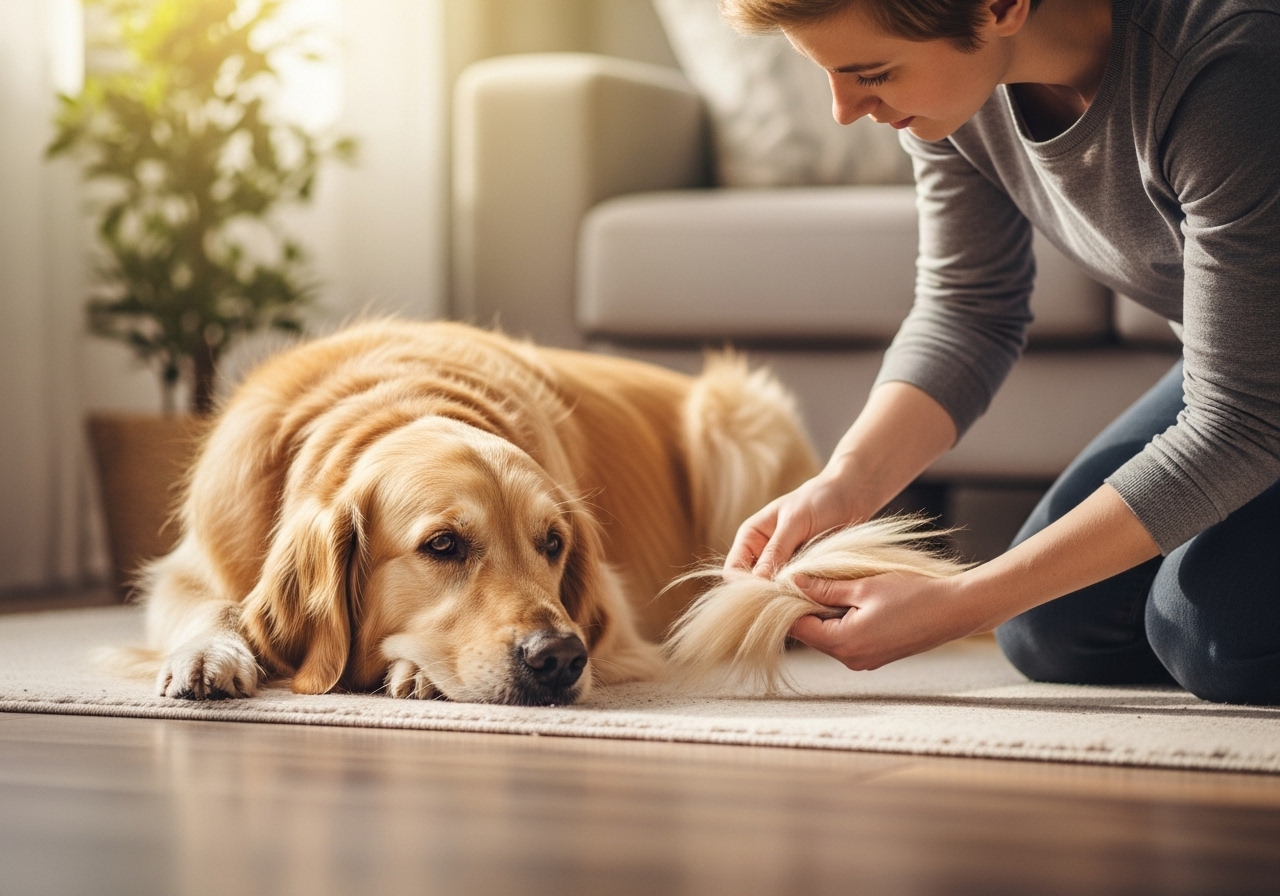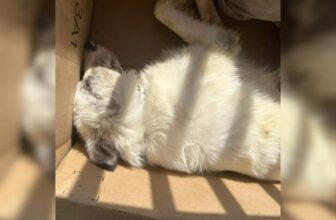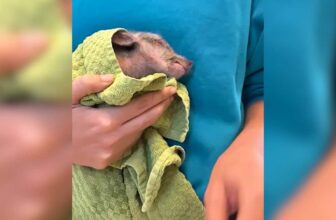
Check out our latest products
Finding a lump near your dog’s bottom can be scary. You might notice it while bathing, grooming, or when your dog starts scooting or licking more than usual. It’s natural to worry, but don’t panic — many lumps are harmless or easy to treat. Still, some can indicate infection, inflammation, or even cancer, so getting it checked early is always the best move.
This article walks you through the most common reasons dogs develop lumps near their bottoms, what symptoms to watch for, and what steps to take next.
First: Stay Calm and Observe
Not every lump is a reason to panic. Dogs often get small bumps as they age or after minor skin irritation. The area around the bottom — called the perianal region — has several glands, muscles, and folds of skin that can swell for different reasons.
Take a moment to observe and note details that will help your vet later:
- Where exactly the lump is located
- Its size, color, and texture
- Whether it’s soft or firm
- If your dog reacts when you touch it
- Any signs of scooting, licking, or pain
Changes in appetite, stool, or behavior can also be clues. Write these down before your vet visit — they’ll make diagnosis much easier.
Common Reasons for a Lump Near a Dog’s Bottom
Here are the most frequent causes vets see — ranging from mild to serious.
1. Blocked or Impacted Anal Glands
Dogs have two small anal glands (or sacs) located just inside the anus. These glands release a strong-smelling liquid when your dog poops, helping them mark territory. When the glands can’t empty properly, the fluid thickens and causes swelling.
Signs include:
- Scooting or dragging the bottom on the floor
- Licking or biting near the tail
- A fishy, unpleasant smell
- Round lump on one or both sides of the anus
If left untreated, the glands can become infected and very painful.
What to do:
- Visit your vet to have the glands expressed (emptied).
- Apply warm compresses if recommended.
- Feed a fiber-rich diet to support regular bowel movements and natural expression of the glands.
2. Anal Gland Abscess
When a blocked gland becomes infected, it can develop into an abscess — a painful, pus-filled swelling that may burst.
Signs include:
- Sudden swelling or redness
- Blood or yellow fluid leaking
- Yelping when sitting or defecating
- Foul odor
What to do:
- See your vet right away.
- The abscess will need to be drained and cleaned.
- Antibiotics and pain relief are usually prescribed.
Quick treatment prevents infection from spreading deeper into surrounding tissue.
3. Perianal Adenoma (Benign Tumor)
A perianal adenoma is a non-cancerous lump that forms in the oil glands around the anus. These are most common in older, unneutered male dogs due to hormone sensitivity.
Signs include:
- A round, firm lump near the bottom or tail
- Slow growth over time
- Mild irritation or hair loss nearby
What to do:
Your vet may recommend:
- Surgical removal of the lump
- Neutering (to reduce hormone levels and prevent recurrence)
Once removed, these tumors rarely return.
4. Perianal Adenocarcinoma (Cancerous Tumor)
Unlike adenomas, perianal adenocarcinomas are malignant and can spread. They often appear similar at first glance but grow faster and may cause pain or bleeding.
Signs include:
- Rapidly growing, hard lump
- Bleeding or ulceration
- Pain during defecation
- Constipation or visible straining
What to do:
- Visit your vet immediately.
- A biopsy or cytology test will confirm diagnosis.
- Surgery, radiation, or chemotherapy may be recommended.
Early detection offers the best chance for recovery.
5. Sebaceous Cysts
A sebaceous cyst is a small, round bump caused by a clogged oil gland. It feels like a soft marble under the skin and can appear anywhere — including near the tail or bottom.
Signs include:
- Smooth, movable lump under the skin
- White or yellow discharge if it bursts
- Rarely painful unless infected
What to do:
- Keep the area clean and dry.
- Avoid squeezing it.
- See your vet if it grows or becomes red and swollen.
Some cysts go away on their own, while others may need minor surgical removal.
6. Perineal Hernia
A perineal hernia occurs when weakened pelvic muscles allow tissue or organs to push through, creating a soft lump near the anus. It’s most common in older, unneutered males.
Signs include:
- Swelling near one or both sides of the anus
- Trouble pooping or peeing
- Straining or discomfort when sitting
- Loss of appetite or tiredness
What to do:
This condition requires veterinary surgery. Your vet will repair the muscle wall and may recommend neutering to prevent future issues.
7. Warts or Viral Papillomas
Warts, or canine papillomas, are caused by a virus and often appear as small, cauliflower-like growths.
Signs include:
- Rough, bumpy texture
- May appear alone or in clusters
- Usually painless and harmless
What to do:
Most warts disappear as your dog’s immune system strengthens. However, if they grow, bleed, or spread, your vet can remove them safely.
8. Insect Bites or Skin Irritation
Not every lump is a gland or tumor. Sometimes it’s just a reaction to an insect bite, flea allergy, or mild infection. Dogs with sensitive skin may develop temporary bumps or redness around the tail area.
Signs include:
- Small, itchy, red lumps
- Licking or scratching
- Slight swelling or scabs
What to do:
- Gently clean the area with mild pet-safe antiseptic.
- Use flea prevention regularly.
- If swelling increases or pus forms, visit your vet for antibiotics.
9. Hot Spots or Infected Hair Follicles
When dogs lick or chew the same area repeatedly, they can develop hot spots — moist, inflamed patches that sometimes look like lumps.
Signs include:
- Red, wet, or crusty sores
- Strong odor or oozing fluid
- Constant licking or biting
What to do:
- Keep the area clean and dry.
- Prevent licking by using a cone or distraction toys.
- Visit your vet for medicated creams or antibiotics.
10. Anal Gland Tumors
Occasionally, tumors form inside the anal glands themselves. These can be benign or malignant and usually cause swelling or hard lumps that don’t go away.
Signs include:
- Firm lump near the anal glands
- Difficulty defecating
- Increased thirst or urination (due to calcium imbalance)
What to do:
See your vet for imaging and testing. Treatment often involves surgery, followed by monitoring.
When to Call the Vet
You should schedule a vet visit if you notice any of these signs:
- The lump grows or changes quickly
- It’s red, painful, or leaking fluid
- Your dog strains to poop or avoids sitting
- The lump smells bad or bleeds
- Your dog becomes tired, eats less, or seems unwell
Even if your dog seems fine, any lump that lasts longer than two weeks should be examined. Early action helps prevent infection and ensures proper diagnosis.
What Your Vet Will Do
During your appointment, the vet may:
- Examine the lump by touch and sight
- Collect a cell sample using fine needle aspiration
- Perform a biopsy if cancer is suspected
- Run blood tests or imaging to check for infection or spread
Based on results, they’ll suggest treatment — whether it’s antibiotics, surgery, or gland expression.
How to Help Prevent Lumps
You can’t stop every lump from forming, but you can reduce risk by keeping your dog healthy and clean.
Helpful tips:
- Feed a balanced, high-fiber diet
- Keep anal glands functioning naturally through regular exercise and firm stools
- Groom and inspect the tail area weekly
- Use flea and tick prevention
- Visit your vet for yearly checkups
Regular care helps you catch small issues before they become big problems.
FAQs About Lumps Near a Dog’s Bottom
Why does my dog have a lump near its bottom after pooping?
It could be a swollen anal gland. If it doesn’t shrink within a day or two, visit your vet.
Can I express my dog’s anal glands at home?
It’s better to have a professional do it. Doing it incorrectly can cause pain or infection.
Are all lumps near the bottom cancer?
No. Many are harmless or related to minor infections. But only a vet can tell for sure.
What if the lump bursts or bleeds?
Clean it gently with warm water and contact your vet immediately. Ruptured abscesses require medical care.
Can female dogs get these lumps too?
Yes. While some conditions are more common in males, females can also develop gland issues or cysts.
Final Thoughts
A lump near your dog’s bottom can mean many things — from minor skin irritation to more serious gland or tumor problems. The key is not to ignore it. Early examination and simple care can prevent pain and complications. Keep your dog clean, maintain a healthy diet, and monitor any changes. Most importantly, schedule a vet visit whenever you’re unsure. A few minutes of attention today can save your dog from bigger problems tomorrow.
Want to understand your dog’s health and behavior even better? Explore our Online Dog Courses — expert-led lessons designed to help you care for your dog confidently and recognize signs of health issues early.
Post Views: 96
Animal Wellness is North America’s top natural health and lifestyle magazine for dogs and cats, with a readership of over one million every year. AW features articles by some of the most renowned experts in the pet industry, with topics ranging from diet and health related issues, to articles on training, fitness and emotional well being.


![[PETHROOM] Cat Nail Clipper Trimmer for Indoor Cats with Circular Cut Hole (2mm) | Premium Sturdy Stainless Steel Blade Cat Claw | Safe, Easy, Accurate, Quiet & Fast | Avoid Overcutting](https://m.media-amazon.com/images/I/6156hi88deL._AC_SL1298_.jpg)
![[PETHROOM] Professional Eye Comb for Pets | Stainless Steel Tear Stain Remover for Cats & Dogs | Gentle Round-Head Grooming Tool | Compact & Portable for Eye Gunk Removal](https://m.media-amazon.com/images/I/71+W758uwXL._SL1500_.jpg)
![[petora] BRUSH ON ME Gentle Facial & Eye Comb for Dogs & Cats | Smooth & Stress-Free Tear Stain Remover | Fine-Tooth Grooming Tool with Rounded Tips | Comfortable Grip for Daily Pet Grooming](https://m.media-amazon.com/images/I/81hzVmjgV1L._SL1500_.jpg)









